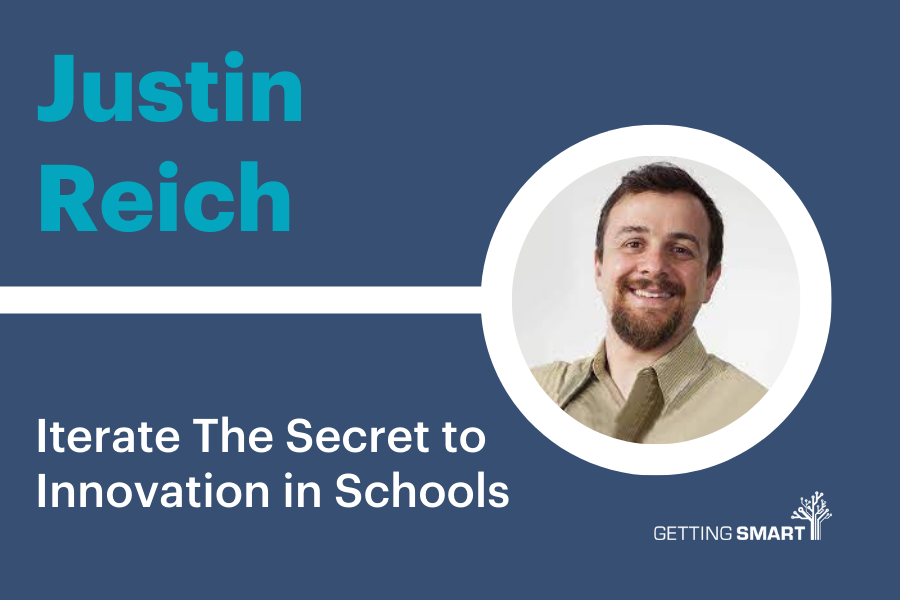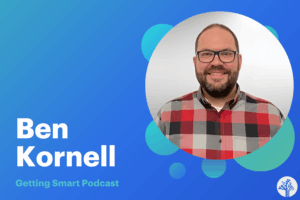Justin Reich on Iterate: The Secret to Innovation in Schools
Key Points
-
Invitational leadership is the critical act of inviting people into a shared vision.
-
Transformational Leadership means starting with understanding, honoring, and respecting what people have already accomplished, and then helping them come together around ideas that will take their work forward.

On this episode of the Getting Smart Podcast, Tom Vander Ark is joined by Dr. Justin Reich, ED of MIT Teaching Systems Lab, host of the Teach Lab Podcast and author of Iterate: The Secret to Innovation in Schools. This book shows the reader how to leverage the cycle of experiment and experience to create a compelling and engaging learning environment. Learn how to employ a process of continuous improvement and tinkering to develop exciting new programs, activities, processes, and designs.
Dr. Reich draws on over two decades of experience with educators, education researchers, and school leaders to explain how to apply the latest advances in the academic literature to your school, classroom, or online/hybrid course.
Links:
Outline
Tom: The signature quality of our very best schools is coherence, said Dr. Justin Reich. He’s our guest on the Getting Smart Podcast today. I think of coherence as where everything works together to support powerful learning experiences. It’s about goals, tools, practices, structures, schedules, and systems all being in sync and relevant to their community. I first experienced this as a big aha moment when I walked into High Tech High and saw what kids were doing. Everything seemed to beautifully work together for teachers and kids. I think there are two pathways to coherence. One is invitational leadership, the kind of leadership Larry Rosenstock exhibited at High Tech High, where you create a beautiful model, a vision, and invite people into that model. The second is transformational leadership, where you may inherit or gain responsibility for a school or district and the task is to take them from incoherence to coherence.
Tom: Dr. Reich said bringing people together around ideas they care about starts with understanding, honoring, and respecting what people have already accomplished and then helping them come together around ideas that will take them forward. That’s transformational leadership. We’re going to talk to Justin about that today. Justin is a professor at MIT and the executive director of the MIT Teaching Systems Lab. He has a great new book coming out called Iterate: The Secret to Innovation in Schools. Welcome, Justin.
Justin: Thanks for having me, Tom.
Tom: Justin, first of all, do you buy that differentiation between invitational leadership—what new schools and programs can do—and transformational leadership? Are those different jobs?
Justin: Yes, it’s much easier to get everybody on the same page if, before they all show up, you write the page and say, “Hey, this is what we’re going to do if you want to come do it with me.” I do this exercise where we once invented this card game called “Committee of N,” where there was kind of a deck of educational tarot cards with various educational values. You would deal a small handful of these values to students or pre-service teachers and say, “Build a classroom that connects personalized learning, hybrid learning, and teacher autonomy,” or “Build a school schedule that connects behaviorism, high test scores, and assimilating immigrants,” all of which are historical purposes of schools. Students start to realize that some of these values fit together nicely, and some don’t fit together at all. One observation I make is that some of our students go to local charter schools in Cambridge and Boston that were designed around a small set of values everyone agrees on. Others go to Cambridge Rindge and Latin, which has been a high school for 150 years, and American society has just been piling values and goals on top of it.
Justin: In both places, we ideally find ways of creating coherence, but it’s a very different journey when you show up at Cambridge Rindge and Latin than when you show up at a charter school.
Tom: This reminds me that it’s interesting that a charter school typically has a nonprofit governing board, and teachers and students are recruited around the mission, so you have mission-focused sustainable leadership. A school board, by definition, is elected to represent a community, comes and goes, and may recreate that mission, so they’re very different animals from governance on up, right?
Justin: Yeah, absolutely. The interesting thing is there are still some parts of the journey towards coherence that are similar if you want a new idea to happen in either place. Larry Rosenstock at High Tech High and all those other great people didn’t get all the answers correct on the first day they started, so they’re still negotiating with their staff to implement new things.
Tom: Here’s an interesting example of that. Even if you’re in an invitational setting and maybe you’re a few years in, there’s a difference. There are two forms of coherence. There’s generative coherence, which invites interaction across nodes to the center, like Larry has done at High Tech High or like Debbie Meyer did at Mission Hill School in Boston, where you’re recreating coherence every week around the faculty table. And there’s oppressive coherence, which is completely top-down. Some charter schools in New York might qualify for oppressive coherence. I think different people try to get to and maintain coherence in different ways. You and I would argue that a generative coherence, one where you’re inviting people to help recreate that system in a dynamic way, is a lot more sustainable, right?
Justin: And a crucial theme of the book is if you’re in a place where schools define a geography, there’s almost no way to create coherence except through an approach that brings people together. Teachers have incredible capacity to make new innovations go away or to participate in top-down directives in only the most minimal, compliance-oriented ways.
Tom: Quick sidebar here. Your book says it’s about innovation, but I think it’s a mixture of improvement and innovation. Do you get hung up, like I do, on the difference between improvement and innovation? Do they require different approaches?
Justin: Not too much. A lot of what I learned in the book was from spending fifteen or so years trying to help schools implement educational technology. Many schools hoped it would bring innovation, taking us from where we are to somewhere really different. In most cases, it did nothing, and where it had benefits, those were probably what you’d call improvements, gaining some efficiencies here or there. But I’m a big believer in continuous improvement. There’s very little research evidence that schools can quickly achieve big changes. My colleague Ken Katinger says that step change is what continuous improvement over 25 years looks like. If you pan back, it can look big, but if you zoom in, it’s lots of little changes.
Tom: This is part of why I’m a big fan of the potential of new school development. New schools are a unique opportunity to take a bundle of ideas and freshly create a coherent model, aiming for real step function innovation, not just iterative changes. That’s hard to do in an existing system.
Justin: Yes, it’s much harder when everything’s already there. New schools often have the advantage of not being asked to serve everyone in the community equally. Comprehensive schools need to do right by all comers, which is a bigger challenge than helping students who are specifically fired up about project-based learning or need more structure in their lives.
Tom: All right, let’s dive into the core insight in your book, this cycle of experiment and peer learning. Where did that come from?
Justin: One of my favorite stories is from visiting a charter school in San Diego soon after Google Docs, a collaborative writing software, was introduced. The school was doing cool things across grade levels and departments with collaborative writing, getting more students peer editing and receiving formative feedback from teachers. I asked what the principals thought about it, and they said the principal didn’t know what they were doing. It made me recognize that teachers change their practice in response to other teachers. Every school community has faculty willing to learn from consultants, follow top-down directives, or try new things on their own. But for most educators, they’re patient pragmatists, waiting for evidence that something will work before fully committing. This has huge implications for school leaders: if you want new teaching and learning to happen, you have a peer learning problem. Teachers need to collaborate and learn from each other. If you’re a teacher, your leadership is essential. Only teachers can implement new practices in classrooms and spread new innovations widely. School leaders need to make that process happen more joyfully, efficiently, and enthusiastically.
Tom: It’s interesting to note that you also came to this through your own teaching practice, getting reps in to improve your own teaching. It’s about getting reps and doing it in community, right?
Justin: Yeah, I had this unusual first job after college teaching wilderness medicine. I taught classes like Wilderness First Aid and Wilderness First Responder over and over again. Each time, I would change the lesson a bit, and I could quickly tell if I taught well by the quality of the improvised splints the students made. In two years, I taught the lesson on improvised splinting 75 to 80 times. Lots of teachers don’t get the chance to teach a lesson that many times in a whole career. Iterate is about ensuring instructional improvement plans aren’t just locked in five-year strategic plans or new courses, but about what we can do on Monday that’s different, to incrementally move towards better practice.
Tom: Let’s extract a couple of leadership lessons. First, don’t assume you can dictate a new learning model with an edict in a loosely coupled system. Real change happens through cycles of experiment and peer learning. Give us some specific examples of how leaders support or encourage experimentation and peer learning.
Justin: You need to create a budget for experimentation in your school. Every school has some teachers excited to try new things. What resources are you giving those folks? Are there special releases from courses or summer pay for teachers to create new resources? Leadership Public Schools in California faced a challenge with Spanish-speaking students needing to take more math and science classes but lacking the academic vocabulary. They used their textbook budget to pay teachers to create resources with academic literacy supports. My second favorite example is schools that buy tablets and Chromebooks. Leadership Public Schools, led by Louise Waters, had a distributed and collaborative innovation agenda where each school took on a set of experiments, collectively adding up to a broader R&D agenda. This breaks up the innovation agenda into smaller parts so that small things can fail without a huge lift, allowing early experimentation and iteration to be light enough to try new approaches and move on if they don’t work.
Tom: That makes sense. Your book also emphasizes the importance of humility and listening for leaders. Can you expand on that?
Justin: One of the biggest challenges for school leaders is that they often come from a teaching background, where the teacher’s role is to know the answer. When you step into a leadership role, the dynamics change. Your job becomes much more about listening and creating the conditions for others to find solutions. It’s about recognizing that you don’t have all the answers and being open to learning from everyone around you. This is particularly important in fostering a culture of experimentation and peer learning.
Tom: So, a leader needs to be a facilitator rather than a director?
Justin: Exactly. Leaders should see themselves as facilitators of collaboration and inquiry. They need to create environments where teachers feel safe to take risks and try new things. This involves building trust, providing the necessary resources, and ensuring there’s a supportive community that values continuous improvement.
Tom: How do you see the role of failure in this process?
Justin: Failure is an essential part of the learning process. It’s important for leaders to normalize failure as a part of experimentation and growth. If teachers are afraid to fail, they won’t try anything new. Leaders need to model this by sharing their own failures and what they’ve learned from them. It’s about creating a culture where failure is seen as a stepping stone to success rather than something to be avoided at all costs.
Tom: That’s a powerful point. Can you give an example of a school that has successfully embraced this approach?
Justin: Sure. One example is the High Tech High network in California. They’ve created a culture where teachers regularly share what’s working and what’s not, both within their school and across the network. They have protocols for peer observation and feedback, and they regularly hold exhibitions where students and teachers showcase their work, including the challenges they faced and how they overcame them. This transparency and openness to learning from mistakes are key to their success.
Tom: It sounds like High Tech High has built a robust system for continuous improvement. How can other schools start to build something similar?
Justin: It starts with leadership. School leaders need to set the tone by being transparent about their own learning processes and by actively fostering a culture of collaboration and experimentation. This can be done through professional development that focuses on peer learning, creating opportunities for teachers to observe each other’s practice, and dedicating time for collaborative planning and reflection. It’s also crucial to celebrate successes and learn from failures openly.
Tom: Speaking of professional development, what are some effective strategies for supporting teacher growth in this kind of environment?
Justin: Professional development should be ongoing and job-embedded. Instead of one-off workshops, schools should provide continuous opportunities for teachers to learn and grow together. This can include regular coaching, collaborative inquiry groups, and time for teachers to experiment with new practices and reflect on their experiences. Schools can also leverage technology to create virtual communities of practice where teachers can share resources and support each other.
Tom: It sounds like building a culture of continuous improvement requires a lot of intentionality and support. What are some pitfalls to avoid?
Justin: One common pitfall is trying to do too much too quickly. Change takes time, and it’s important to pace yourself and prioritize. Another pitfall is not involving teachers in the decision-making process. Teachers are more likely to buy into new initiatives if they feel they have a voice in shaping them. Lastly, it’s important to avoid a top-down approach to innovation. Leaders should facilitate and support rather than dictate what changes should happen.
Tom: That’s great advice. As we wrap up, what’s the one piece of advice you’d give to school leaders who are just starting this journey?
Justin: Start by building strong relationships with your teachers. Listen to their needs and aspirations, and involve them in the process of creating a shared vision for your school. Focus on creating a culture where experimentation and peer learning are valued, and be patient. Real change takes time, but with commitment and collaboration, it’s definitely possible.
Tom: Thank you, Justin. This has been an enlightening conversation. For those interested in learning more, be sure to check out Justin’s new book, Iterate: The Secret to Innovation in Schools. Thanks for joining us today.
Justin: Thank you, Tom. It’s been a pleasure.
Tom: Thanks to everyone for listening. Be sure to subscribe to the Getting Smart Podcast for more conversations on the future of learning. Until next time, keep learning.







0 Comments
Leave a Comment
Your email address will not be published. All fields are required.